Manufacturer News
How Much is Too Much for EV Driving Range?

How long should an EV be able to travel on a full battery? ‘Neue Klasse’, from BMW, suggests that 1000 kilometres is about right. BMW’s New Class of vehicles are not far off the runway now, said to be arriving in 2025. And they are going to be the first BMWs-ever that have been designed from the ground up to be specifically all-electric, EV through-and-through.
That does raise an interesting question: How far should we expect our brand spanking new EVs to go on a full charge (a full tank of electrons instead of a full tank of gas)? Should we be able to drive from Sydney to Melbourne (877 km), Sydney to Adelaide (1374 km), Sydney to Cairns (2430 km), Sydney to Perth (3932 km), or just Sydney to Wollongong and back (about 175 km) on a full battery?
Most of us are probably sick of driving non-stop after 6–8 hours max in a day. So, say most of that was done at 100 km/h, then 100 × 8 hours would get you to 800 kilometres before you’d be needing a proper cup of coffee in a proper coffee cup! It would be then you’d want a rest and a sleep, right?
Perhaps Neue Klasse has got it bang on then. 1000 km would cover an all day blast up the coast from Sydney to Brisbane, which is approximately a total of 911 kilometres via the coastal route. Get to the end of that journey, and you could pull up at a mate’s place for tea, or a motel, and plug in your EV overnight ready for the long drive back home.
According to Thomas Albrecht (BMW’s head of Efficient Dynamics), in 2025, New Class EV BMWs are set to have “thirty-percent or more” range than what’s currently available now. That means that the brand-new BMW EV platform with lots of fresh pieces of technology, including 46 mm cylindrical battery cells, should push the Generation 6 batteries out to around 1000 km before they run out of electron juice. Even though BMW could go further than this 1000 kilometre range, Albrecht suggested that this would be the maximum that BMW will offer because they don’t think that such a long range is necessary.
BMW will debut the new Generation 6 batteries in the 2025 BMW 3 Series EV. How much do you think we should be able to get out of the battery packs in any new EV bought in 2025–2030? I’d be interested to know – remembering that battery tech and recharging times will likely have vastly improved by then.
The Lithium Rush

Lithium is in very hot demand at present. Like a new frenetic modern-day gold rush, it seems that big companies wanting lithium are frantically looking for this new sort of gold.
Obviously, lithium is required in the production of lithium-ion battery cells that are used for powering EVs. In order to make sure that they don’t run short of lithium anytime soon, China, which has the largest EV market in the world, produces 80% of the world’s usable lithium product all on their own. In a statement recently, Sung Choi, a metals analyst, stated that “The cost of lithium has risen because virtually all automakers have jumped onto producing EVs.”
Currently, over half of the world’s lithium resources are in South America and Australia. As prices for lithium are surging – and some metal analysts at BloombergNEF (BNEF) have witnessed an almost 500% increase in the past year – China seems to be leading the charge in the hunt for new lithium mining reserves.
China is searching around the world for new lithium deposits that can supply their big need for the metal used in EV production. China has even looked at the Qinghai-Tibetan plateau as a source for the metal, as well as in Africa. Sung Choi also said that “Africa has recently been in the spotlight with its ample resources in metals.”
Some of the African lithium mining fields being looked at by China include the reserves found in the Democratic Republic of Congo, where Zijin, a Chinese mining giant, is battling with Australia’s AVZ minerals over controlling the DRC’s Manono mine. Quite possibly, the Manono mine has the world’s biggest lithium deposit.
Last year, Congolese President Félix Tshisekedi said that people living in areas with mines were “still languishing in misery,” while it was the foreign multinationals running the mines who prospered. The mines do provide locals with jobs, but many would say that the locals don’t see enough trickle-down reward from the massive multimillion-dollar projects.
Also, in Zimbabwe there are large untapped deposits of lithium, and China is rapidly buying up these resources. Zhejiang Huayou Cobalt, a Chinese-based company, has recently purchased Arcadia Lithium mine outside Harare. The money (some $300 million) will be used to construct a mining plant with a processing capacity of 400,000 metric tons of lithium concentrate per year. The Zimbabwean government has welcomed this recent investment, looking forward to helping fill China’s and the EV’s need for lithium-based batteries.

The current and potential growth of the EV industry, and therefore the rush for new lithium resources, has had companies like Tesla seriously considering getting into lithium mining and refining directly for themselves. Maybe it is Toyota who is taking the more manageable approach to the mass production of EVs. Their pace toward an EV transfer seems to take a better-calculated methodology when compared with some other big automotive manufacturers who seem driven on producing a fleet of their own EVs as fast as possible. Toyota sees the value in hybrid technology building a bridge to solving any issues around climate change and the EV mindset.
Lithium isn’t just used in the production of EV battery packs. Lithium is also used in rechargeable batteries for mobile phones, laptops, digital cameras, and in warfare equipment. It is also used in some non-rechargeable batteries for things like heart pacemakers, clocks, and toys. The future and the course of EV production and EV uptake does seem to depend on the amount of lithium being available and the costs involved for mining it. These costs will affect how much a new climate change-solving EV might eventually sell for.
New Cars to Buy – Exciting!
Along with the new SUVs showcased last time, Australia will also see some other exciting vehicles arriving in the coming months. Keep your eyes out for the following:
Honda
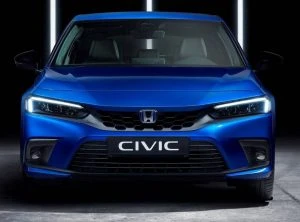
Civic Hybrid
Honda’s new Civic hybrid has its own subtle design features that set it apart from other Civic models. Hybrid-specific displays for the infotainment screen and instrument cluster gives the car its own environmentally friendly twist, plus the revised rear bumper is designed to conceal the exhaust outlets. Honda’s Civic Hybrid also gets blue accents for its Honda badges, and there is a special e:HEV tailgate badging to set it off nicely.
As a driver, the new Honda Civic Hybrid is an impressively competent vehicle with great economy and plenty of get up and go. The Civic HEV’s hybrid system is based around the 2.0-litre naturally-aspirated Atkinson-cycle petrol motor that is found in the current Honda Accord VTi-LX Hybrid. Matching the engine output to a smooth CVT automatic makes for an excellent easy car to drive. 315 Nm of torque provides grunt when you need it and the 135 kW of peak power suits this car well and delivers a bigger punch than the standard Civic’s 131 kW/240 Nm levels.
The front-wheel drive Honda Civic Hybrid is likely to be more efficient than the Accord Hybrid and even more so than Toyota’s Corolla Hybrid (4.2 litres/100 km).
BYD
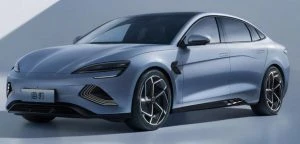
BYD Atto 4
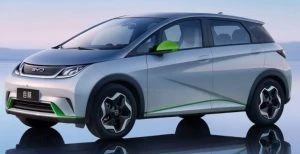
BYD EA 1 (Dolphin)
BYD Auto is the largest EV manufacturer in the world and is the automotive division of the Chinese multinational manufacturer BYD Company. Along with some SUV models, BYD is also bringing their Atto 4 sedan and their neat little EA 1 to Australia.
The BYD Atto 4 is a mid-size sedan that looks beautiful, sporty, and aerodynamic. Equipped with loads of the latest technology and also obtaining power from large batteries with a unique design, the Atto 4 impresses. Standard Atto 4 versions get a 61.4 kWh battery pack and a claimed 550 km range. The pricier models get a larger 82.5 kWh unique Blade battery with a claimed range of up to 700 km. Having the larger battery and an AWD system, this flagship BYD Atto 4 can reach 100km/h from a standstill in just 3.8 seconds!
More BYD excitement has the imminent arrival of the BYD EA 1 Hatchback. In China they call the BYD EA 1 the rather endearing name ‘BYD Dolphin’. This is a small Chinese EV hatchback that is being picked to be priced at or less than $30,000 in Australia. The small all-electric hatchback will be available with various battery and drivetrain configurations, all using a single electric motor to power the front wheels.
Two battery capacities: 30.7 kWh or 44.9 kWh will be available for the EA 1, both of which can be paired with a 70 kW/180 Nm motor. The larger 44.9 kWh battery can also be linked to a 130 kW/290 Nm motor, providing swifter acceleration and cruising speeds. Larger batteries will also become available over time for the little EA1 – particularly necessary, as Australia is a pretty vast land mass.
Managing director, Luke Todd, stated that “Our view is [that] in Australia any EV must have a minimum – even for city running – of 400 km to be accepted in the Australian market. All of our vehicles will have at least a 400 km range … our target is 500 km-plus.”
Cupra
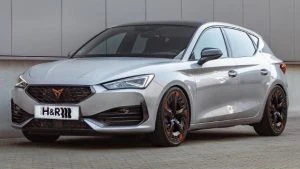
Cupra Leon
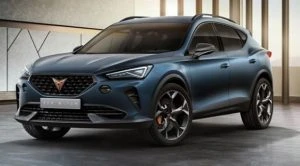
Cupra Formentor
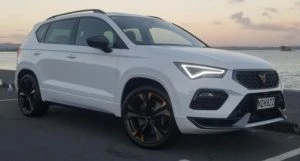
Cupra Ateca
Cupra is a Volkswagen-owned Spanish brand who have opened their doors to import their vehicles to Australia, offering us a 3-strong model range.
The exciting range of Cupra cars – Ateca (SUV), Leon (Hatchback), and Formentor (Crossover) – will spearhead the Australian line-up.
The Cupra Ateca SUV comes exclusively in the VZx form, so 221 kW of power and 400 Nm of torque is sent through the 4Drive AWD system to deliver 0-100 km/h in 4.9-seconds. I can see plenty of performance-SUV lovers who want to drive something as unique looking as the Cupra Ateca SUV wanting one!
The Cupra Leon Hatchback will be offered in VZ, VZe and VZx specification levels. So along with plenty of technology and differing variants, there will be a 2.0-litre turbo 140 kW/320 Nm, 180 kW/370 Nm, 180kW/400 Nm (Hybrid), and 221 kW/ 400Nm outputs respectively. So, there’s something for everyone here!
The Cupra Formentor is the Crossover Cupra and boasts the 4Drive AWD system on the V and VZx variants. Note the gorgeous crossover body styling that brings with it plenty of space, practicality and comfort.
All new Cupras sold in Australia will include a 5-year, unlimited kilometre warranty.
Volvo
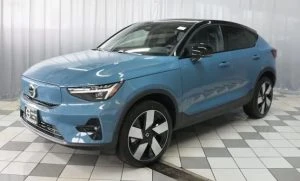
Volvo C40
Volvo has a new C40 coming! There are two versions offered that are based around one having a single electric motor and the other a dual electric motor layout. The Volvo C40 shares the electric powertrains with the XC40. Boot space is measured at 413 litres for both the single and dual motor versions.
Volvo’s the single motor C40 uses a 69 kWh battery pack and a single electric motor over the front axle. It produces 170 kW of power and 330 Nm of torque, combining nicely to provide drivers with a potential 0-100km/h dash being finished in 7.4 seconds. A full charge has a range of over 400 km.
Jump over to the Volvo C40 with its dual motor system, and you’ll find a larger 78 kWh battery pack. An electric motor for the front axle and an electric motor for the rear axle has this Volvo C40 equipped with AWD and capable of seeing off the 0-100km/h sprint in a claimed 4.7 seconds. That’s pretty swift! Again, a full charge should be able to take you over 400 km.
The single motor Volvo C40 kicks off at around $74,990, and the dual motor model around $82,490.
Audi
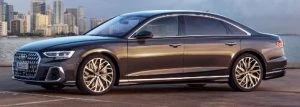
Audi A8
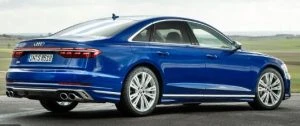
Audi S8
Audi’s A8 and S8 facelifts are coming. The A8 Sedan and Audi’s sportier S8 version have been a stunning proposition for some time, and they keep getting better. Quite an attractive large and luxurious sedan, the 2022 A8 delivers new levels of technology in the areas of comfort, entertainment, and safety.
The stunning A8 exterior remains similar to the outgoing model but you will find some nice subtle changes on the outside. 18–21-inch rims are available with six new designs to choose from. Audi’s ‘singleframe’ grille has been widened and pushed out at the bottom corners for a sportier, more athletic appearance.
The luxury sedan has grown a bit longer, making Audi’s flagship even more comfortable. It competes with the best big sedans from Mercedes Benz, BMW, and Lexus, so the relaxation seat package comes as no surprise, adding a back massage function, a foot warmer, an optional centre control console, and a fold-out table. 23 Bang and Olufsen speakers create an amazing audio sound.
Around the world, the new Audi A8 and A8 L versions will offer a wide selection of chiefly twin-turbo V6 engines that have 48-volt mild-hybrid assistance. All models will boast Quattro AWD and an 8-speed automatic. Audi S8 versions get the sweet-singing twin-turbo 4.0-litre V8 petrol ICE that can move this luxury–sports sedan from 0-100km/h in just 3.8 seconds. Boasting all-wheel steering, the S8 is a nimble thing of beauty.
Citroen
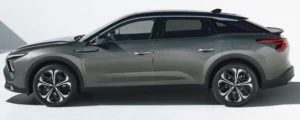
Citroen C5 X
Citroen calls the C5 X a “unique combination of the elegance of a sedan, the dynamism of a wagon and the elevated stance of an SUV”.
In my eyes, the new Citroen C5X looks both elegant and comfortable – just like a special Citroen should. The Citroen C5 X is a large 5-seater that measures 4805 mm in length. Luggage capacity is 485/1580 litres for the PHEV version and 545/1640 litres for the ICE car. Inside its cabin, you’ll find the C5 X is very comfortable, and the sensible interior layout is pleasant on the eye. A load of high-tech interior features include a digital driver’s display, a big 12.0-inch central touchscreen, Android Auto, Apple CarPlay, and a novel toggle gear shifter.
Adaptive dampers increase the Citroen C5 X’s ability out on the road, ensuring that those of us who love comfort can ride all day in a C5 X, all very comfortably indeed.
Equipped with the 165 kW/300 Nm 1.6-litre turbo-petrol four-cylinder ICE, the Australian version will have decent power (0-100 km/h in 8.8 seconds) while being hooked up to an 8-speed automatic transmission and FWD. A top speed of 232 km/h is doable. Citroen’s Australian importer is also considering launching the new Citroen C5 X with a PHEV powertrain. This system mates the 1.6-litre turbo ICE with an 81.2 kW electric motor and a 12.4 kWh lithium-ion battery for a total system output of 165 kW and a claimed electric range of 50 km (WLTP). The PHEV version is slightly quicker, boasting a 7.9 second time for the 0-100 km/h dash.
Peugeot
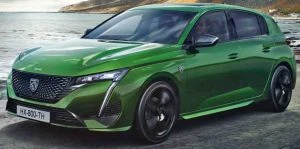
Peugeot 308
Peugeot is bringing us the next-generation 308 and the 3rd generation 308 is a classy looker from any angle you care to look at it from the curb side. Peugeot’s Australian line-up will consist of 4 variants: the 308 GT Hatch, 308 GT Premium Hatch and Wagon, and the Peugeot 308 GT Sport PHEV hatch – a plug-in hybrid (PHEV).
The PHEV versions of the 308 Hatch and Wagon will use larger batteries and more powerful motors than you’ll find in the smaller Peugeot e-208 supermini models. A Peugeot 308 GT Sport PHEV model sees a 132 kW 1.6-litre turbocharged 4-cylinder ICE unit paired to an 81 kW electric motor. The total output of the powertrain sends out a sprightly 165 kW of power and 360 Nm of torque to an AWD system for maximum traction and plenty of excitement.
New 308s with ICEs will be powered by a 1.2-litre turbocharged 3-cylinder petrol engine that produces 96 kW of power and 230 Nm of torque. This little engine is paired with an Aisin-sourced 8-speed automatic transmission that sends the power to the front wheels. Peugeot offers an e-308 in Europe, which is a pure electric variant.
Ford
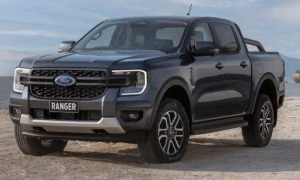
Ford Ranger Ute
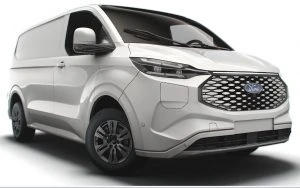
Ford E Transit
The new Ford Ranger Ute is packed with smart functionality and a cool ‘Tonka Toy’ appearance. Commands via voice, phone, or the central touchscreen has you controlling many of the infotainment features. Wireless phone charging, a smart climate control system, and a new digital cluster for the driver keeps the tough new Ford Ranger models at the head of the pack. Its chunkier styling with a wider stance, big towing capacity, and superior off-road ability are part of the new Ford Ranger experience.
Like the brand new Ford Everest SUV, the Ranger Ute houses the latest 3.0-litre turbo diesel V6 ICE, which is also offered alongside the existing 2.0-litre twin-turbo 4-cylinder diesel engine for 2022/23. The V6 boasts 184 kW of power at 3250 rpm and 600 Nm of torque from 1750-2250 rpm.
Ford’s latest E-Transit vans will be available with an all-electric powertrain for more efficient, zero-emissions driving.
Genesis
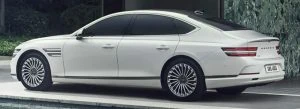
Genesis G80 Sedan
The charming Genesis G80 Sedan has gone pure EV and it is a stunner on the styling front. The car’s opulence and quiet ride will impress. An 87.2 kWh lithium-ion battery pack is housed under the floor, and a claimed Worldwide Harmonised Light Vehicle Test Procedure (WLTP) range of over 500 km is a decent amount of travel. The G80 EV Sedan has a pair of electric motors that work in unison to develop a maximum of 272 kW. This level of power combines with instantaneous torque of up to 700 Nm. These are powerful figures, allowing the luxurious Genesis Sedan to sprint from 0-100 km/h in less than 5 seconds.
Funky New SUVs To Buy
Here’s some new SUVs that have already arrived or will be arriving in Australia over the next little bit. Many of them are new Hybrid, PHEV or EV SUVs. There’s something for everyone, so keep your eyes out for the following:
SsangYong Torres

An exciting vehicle to arrive in Australia early 2023 will be the new SsangYong Torres. Those of us who like to find places off the beaten track will enjoy the Torres off-road capable models. A turbocharged petrol ICE will be mated to a 6-speed Aisin automatic transmission, and there will be FWD and AWD versions available.
Ssangyong will offer the Torres with 17-inch alloy wheels on lower grades through to 20-inch wheels on higher trims. Safety features include 8 airbags, adaptive cruise control, cross-traffic alert, autonomous emergency braking, blind-spot monitoring, and safe exit warning.
The new Torres is similar in size to a Mitsubishi Outlander. 703 litres of boot space is available when all 5 seats are up, or there’s a decent 1662 litres available when the second row is folded flat. A huge central 12.3-inch touchscreen rules the dash space, and drivers get a great looking digital display. Functions like the climate control and ventilation modes are found on an additional 8.0-inch touchscreen fitted below the prominent 12.3-inch screen.
Mazda CX-60

Mazda has another new SUV. Now that might sound as if I’m pulling your leg, with Mazda already providing a great line-up of SUVs across the board. However, the new CX-60 will be a luxury SUV competing directly against other big luxury names – like luxury SUVs from Audi and BMW. So, you should start getting the idea that the CX-60 is an SUV of a much higher standard than Mazda’s existing CX-5, CX-8 and CX-9 models.
The Mazda CX-60 will be comfortable and offer an impressive array of features and safety. With its 2.5-litre plug-in hybrid powertrain, the new Mazda CX-60 SUV will also offer the most powerful 4-cylinder engine Mazda has produced – the 241 kW of power and 500 Nm of torque is set to impress.
Suzuki S-Cross

Suzuki has their new small S-Cross SUV available for order. It is built in Hungary. The design is pleasant and practical, with plenty of comfort and space in its offering. Inside the latest S-Cross is a new 9.0-inch touchscreen display, and there’s a strong suite of driver-assistance features available as standard for all models – things like blind-spot monitoring, lane-keeping aids, adaptive cruise control, and AEB to name a few.
Under the bonnet you’ll find a turbocharged 1.4-litre petrol ICE. An ‘AllGrip’ AWD system means that you can get yourself out to some pretty remote places, and Australia hopefully will get the European version’s 48V mild-hybrid system –but we’ll wait and see on that one.
BYD Atto 3

No, BYD isn’t a new take on BYO (Bring Your Own). BYD stands for Build Your Dreams, and BYD Auto has delivered on the name because they are the largest EV manufacturer in the world. BYD Auto is the automotive division of the Chinese multinational manufacturer BYD Company. BYD has designed and developed many new ‘green’ products enjoyed by many around the globe – such as LED technology, solar farms, battery energy storage stations, and, of course, EVs.
The new BYD Atto 3 is an EV SUV. Pricing is very good, especially when you compare it with other EV SUVs – BYD now making an EV SUV much more affordable and accessible to the masses. The new BYD Atto 3 offers great EV SUV transport that, in normal everyday driving, will perform well, having a real world driving distance of between 350 and 400 km on a full charge. The quiet and comfortable electric progress makes for easy driving, and it’s pretty practical as well, with 434 litres available behind the back seats or 1330 litres when the back seats are folded flat. 0-100 km/h can be all over in a little more than 7 seconds.
Chery Omada 5

Chery is delivering the Chery Omada 5 Crossover SUV. Boasting peak output figures of 150 kW of power and 400 Nm of torque, and a 64 kWh battery that provides a WLTP-rated range of 450 km, these performance figures are stacking up nicely. The FWD Chery Omada 5 SUV also promises competitive pricing for an EV, plenty of practical space, and all the modern technology you’ll need for EV communications while at work and at play.
Genesis GV70 and GV60
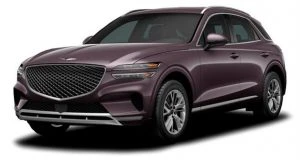
GV70

GV60
Genesis’s luxury GV70 is a pure electric SUV. The GV70 electric versions have been adapted to take a 77.4kWh lithium-ion battery pack and a pair of electric motors that combine to produce up to 360 kW of power and 700 Nm of torque. The resulting 0-100k/h sprint time is a cracking 4.2 seconds. Genesis quotes a WLTP range of 450 km-plus.
For something a little funkier, Genesis also brings us the new Genesis GV60. The GV60 shares its platform with the Kia EV6 and Hyundai Ioniq 5. You’ll also note that the interior of the Genesis GV60 appears familiar with an EV6 or Ioniq 5, but just a whole lot more luxurious.
Two models of the new Genesis GV60 are available: the standard GV60 AWD (234 kW), and the GV60 Performance (360 kW). The Performance variant of the GV60 raises the power output of both electric motors to 180 kW for the rear and 180 kW for the front. This results in a total output of 360 kW enabling the GV60 Performance AWD to accelerate from 0 to 100 km/h in 4.0 seconds (4.6sec without Boost Mode). A rear limited slip differential (E-LSD), black monobloc front brakes, and an adaptable electronic suspension that reads the road are part of the impressive GV60 Performance features.
Buy a standard Genesis GV60 AWD, and you get a 160 kW motor for the rear axle and a 74 kW motor for the front axle, totalling 234 kW for peak output and a maximum torque of 605 Nm.
Nissan
New Qashqai, X-Trail, and Pathfinder
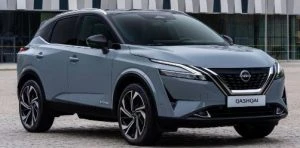
Qashqai
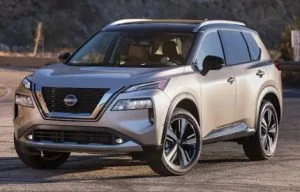
X-Trail
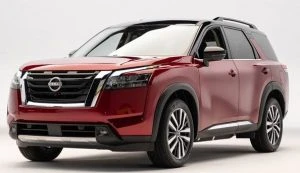
Pathfinder
More muscular, sharper in detail, and definitely a little suaver, the new Nissan Qashqai looks fantastic. With prominent shoulder lines, a new enlarged Nissan V-motion grille, and slim, full LED advanced matrix headlamps with boomerang signature daylight running lights, the Qashqai is impressive. Nissan certainly makes the Qashqai an attractive SUV for buyers wanting a capable and practical smaller SUV. With all the latest technology and luxury, the new Nissan Qashqai also offers its buyers an ePower powertrain in the full Qashqai line-up, meaning that the ePower system offers full electric driving where the wheels are completely driven by electric motors.
Nissan’s new X-Trail has similarly striking looks, new technology, and lots more to offer with its pleasant drive, comfort, and safety features.
Then there is the latest Nissan Pathfinder, delivering the ultimate family SUV 4×4 Crossover experience. The latest 9-speed automatic transmission delivers quick response and enhanced traction. With the all-new Intelligent 4×4 system a very capable one, you can select 1 of 7 available drive modes for on and off-road work.
Ford Everest

Ford claims the new big Ford Everest SUV has strong capability across all facets, especially when it comes to power, safety, and comfort. A very complete and likable SUV, the Everest is built tough, and yet delivers a nice and serene haven for its occupants on the inside. You can be sure that the 2022 Ford Everest is ready for everything your travels entail, including towing with a full load and the entire family.
Ford’s new Everest SUV has a strong on-road presence with a very horizontal fascia at the front that creates a rugged, tough look. The new grille with its distinctive C-Clamp LED headlamps showcases Ford’s tough design. Ambiente, Trend, Sport, and Platinum models are available for buyers.
The Everest houses the new 3.0-litre turbo diesel V6 motor, which is offered alongside the existing 2.0-litre twin-turbo 4-cylinder diesel engine. The V6 boasts 184 kW of power at 3250 rpm and 600 Nm of torque from 1750-2250 rpm. These two engines are also available in the new Ford Ranger ute, which is what this Everest SUV is built upon.
Alfa Romeo Tonale

Alfa Romeo’s Tonale is set to arrive early in 2023. As an entry-level model, the Tonale Super competes against Lexus, Mercedes Benz, BMW, Audi, and Volvo. The Tonale Ti is the top of the range model, easily rubbing shoulders with the best from out of these other luxury brands.
Plenty of the modern electronic technology is present, with 4G connectivity and voice-activated Amazon Alexa built into the new Tonale. It will be powered by a petrol–electric hybrid powertrain which is based around a new 1.5-litre turbocharged 4-cylinder ICE. Its pleasant Italian looks won’t go unnoticed.
BMW X1

One of the Tonale’s competitors will be BMW’s new X1 SUV. The X1 is a nice small SUV cruiser – larger than before though – and the exterior looks great, even a bit smarter than the outgoing models. Thus, with the increase in size, the luggage capacity has also grown from 505 to 550 litres and will expand to a maximum of 1600 litres when the 40/20/40 split-folding rear seats are folded flat. LED headlights and tail-lights are fitted as standard, with Matrix LED headlights available on higher trims.
Inside the new BMW X1 there is a re-designed and remodelled interior to enjoy. BMW also provide buyers with a fully-electric X1 – known as the BMW iX1. The third-generation BMW X1 covers all the bases with diesel, plug-in hybrid, petrol, and now electric variants being available for the global market. So far, petrol and electric models have been confirmed for the Australian market.